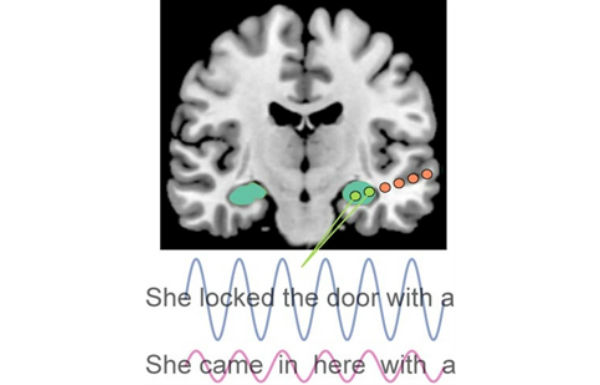A new study shows that when you finish your spouse’s sentences or answer a fill-in-the-blank question, you’re engaging the brain’s relay station for memories, the hippocampus. Until now, scientists largely neglected this area in relation to language. The new experiment conducted by researchers at UC Berkeley and Vitoria Piai, neuroscientist at Radboud University’s Donders Institute, shows that memory and language are in fact deeply linked via the hippocampus.
Nestled in the center of the brain, the hippocampus acts like a router to link related memories—the color, shape, feel, scent and taste of an orange, for example—so that we are able to make associations. In the new study, direct brain recordings reveal that the brain region is also active during language processing. It relates incoming words to stored semantic knowledge, which is necessary in understanding and generating sentence meaning, the researchers say.

A cross-section of the brain with the hippocampus colored aquamarine in each hemisphere. The depth electrode penetrates to the hippocampus through the lateral temporal lobe and makes contact at six points, represented by the colored circles. The theta activity coming from the hippocampus is stronger, and thus more synchronized, for sentences with an obvious completion (upper wave) as opposed to sentences without an obvious completion (bottom). (Credit: Vitória Piai)
Intracranial Recordings
Language studies most often employ functional magnetic resonance imaging (fMRI), which measures oxygen flow in the brain, a slow process that doesn’t allow researchers to measure activities that take place in a fraction of a second. This new study however was conducted in twelve epilepsy patients undergoing intracranial electrode monitoring at the UC Irvine Medical Center and Stanford University Medical Center to locate the source of their abnormal brain activity. The researchers recorded neuronal activity from the non-epileptic hemisphere of the brain, using electrodes inserted into the hippocampus.
During the experiment, people heard fill-in-the-blank sentences with an obvious completion: “He swept the floor with a ____,” for example.
In 10 of the 12 subjects, listening to sentences that had an obvious completion—the constrained sentences—caused a burst of highly synchronized activity (theta waves) in the hippocampus, activity characteristic of the hippocampus when it makes a memory association. This is a sign that the region was making associations throughout the brain to come up with the right word, in this case: broom.
Language in Real Time
According to Vitória Piai, former UC Berkeley postdoctoral fellow and now a senior researcher at Radboud University’s Donders Institute and Radboud University Medical Center, depth-brain recordings capture millisecond by millisecond neuron firings, showing precisely how the brain deals with language in real-time. “This experiment is so exciting because of the possibility that we will start to understand language and memory in a more integrated way, start examining language as it really happens.”
The new findings could open up a whole new area of study with intracranial recordings to probe details of the connection between language and memory. UC Berkeley professor Robert Knight, co-author of the publication, said: “This study shows that memory contributes as a sentence is evolving in time; it is a real-time part of our language system, not a slave to the language system.”
The research is supported by the Netherlands Organization for Scientific Research, National Institutes of Health (NINDS R37 NS21135; NINDS K23 NS060993; NINDS F32 NS082065), U.S. Department of Veterans Affairs Clinical Sciences Research and Development Program, Stanford NeuroVentures Program, National Institute of Neurological Disorders and Stroke (R01NS078396), National Science Foundation (BCS1358907),and by the Nielsen Corporation.
(Source: AlphaGalileo)




